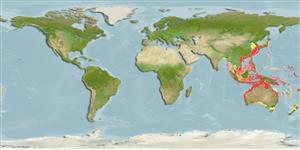Environment: milieu / climate zone / depth range / distribution range
Ekologi
marina bottenlevande. Tropical
Indo-West Pacific: northwestern Australia.
Size / Vikt / Age
Maturity: Lm ? range ? - ? cm
Max length : 17.8 cm SL hane/ej könsbestämd; (Ref. 3131)
Occurs in the sublittoral zone on sand bottoms (Ref. 11230).
Life cycle and mating behavior
Maturities | Reproduktion | Spawnings | Egg(s) | Fecundities | Larver
Sainsbury, K.J., P.J. Kailola and G.G. Leyland, 1985. Continental shelf fishes of the northern and north-western Australia. An illustrated guide. CSIRO Division of Fisheries Research; Clouston & Hall and Peter Pownall Fisheries Information Service, Canberra, Australia. 375 p. (Ref. 3131)
IUCN Red List Status (Ref. 130435)
Threat to humans
Harmless
Human uses
Verktyg
Special reports
Download XML
Internet-källor
Estimates based on models
Preferred temperature (Ref.
123201): 15.7 - 27.7, mean 25 °C (based on 465 cells).
Phylogenetic diversity index (Ref.
82804): PD
50 = 0.5001 [Uniqueness, from 0.5 = low to 2.0 = high].
Bayesian length-weight: a=0.00589 (0.00232 - 0.01492), b=3.07 (2.85 - 3.29), in cm total length, based on LWR estimates for this (Sub)family-body shape (Ref.
93245).
Trofisk nivå (Ref.
69278): 3.4 ±0.44 se; based on food items.
Generation time: 2.3 ( na - na) years. Estimated as median ln(3)/K based on 1
growth studies.
Resiliens (Ref.
120179): Hög, lägsta populationsfördubblingstid mindre än 15 månader (K=0.4).
Fishing Vulnerability (Ref.
59153): Low to moderate vulnerability (26 of 100).
